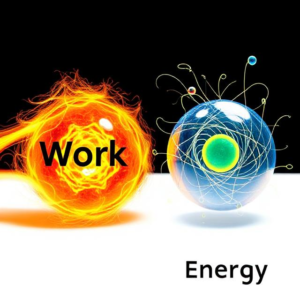What is the Work-Energy Theorem?
The Work-Energy Theorem is a fundamental concept in physics that relates work to energy. It states that the work done on an object is equal to the change in its kinetic energy.

In simple terms:
- Work is done when a force acts on an object and causes it to move.
- Energy is the ability to do work, and an object’s kinetic energy is the energy it has due to its motion.
Work-Energy Theorem Formula
The formula for the Work-Energy Theorem is:
Where:
- W = work done on the object (in joules, J)
- ΔKE = change in kinetic energy of the object (in joules, J)
The change in kinetic energy (ΔKE) is given by:
Where:
Kinetic energy (KE) is calculated using the formula:
Where:
- m = mass of the object (in kilograms, kg)
- v = velocity of the object (in meters per second, m/s)
What Does This Mean?
When a force acts on an object and causes it to move, it does work on the object. This work changes the object’s kinetic energy. The object could speed up, slow down, or change direction. The Work-Energy Theorem tells us how much the object’s speed changes based on the work done on it.
Key Concepts to Understand:
- Work:
- Work is done when a force causes an object to move in the direction of the force.
- If no movement happens, no work is done (even if a force is applied).
- The formula for work is
, where:
- F = force applied (in newtons, N)
- d = distance the object moves (in meters, m)
- Kinetic Energy:
- Kinetic energy is the energy an object has because it is in motion.
- It depends on the object’s mass and velocity: the faster it moves and the more mass it has, the more kinetic energy it has.
Work-Energy Theorem in Action
Let’s break it down with an example:
Example 1: A Car Accelerating
Imagine you have a car of mass 1000 kg that starts from rest (initial velocity = 0) and accelerates to a speed of 20 m/s.
- The initial kinetic energy (KE_initial) is:
- The final kinetic energy (KE_final) when the car reaches 20 m/s is:
- The change in kinetic energy (ΔKE) is:
This means that the car’s kinetic energy increased by 200,000 joules as it accelerated to 20 m/s.
Work Done on the Car:
According to the Work-Energy Theorem, the work done on the car is equal to the change in its kinetic energy.
So, the work done on the car by the force (like the engine) to accelerate it to 20 m/s is 200,000 joules.
Key Points to Remember:
- The Work-Energy Theorem connects work and energy: It tells you that the work done on an object is equal to the change in its kinetic energy.
- Work is energy transfer: When work is done on an object, energy is transferred to or from the object, changing its motion (kinetic energy).
- If the object is speeding up, the work done on it will be positive, and the kinetic energy will increase.
- If the object is slowing down, the work done on it will be negative, and the kinetic energy will decrease.
- No work, no change in energy: If no force is acting on an object (or if the force doesn’t cause any movement), no work is done, and there is no change in the object’s kinetic energy.
Example 2: Slowing Down a Car
Imagine the car from the previous example is now coming to a stop. It is initially moving at 20 m/s and finally stops (v = 0).
- The initial kinetic energy:
- The final kinetic energy:
- The change in kinetic energy:
The work done to stop the car is negative because the car is losing kinetic energy. The amount of work done to stop it is -200,000 joules, meaning energy is being transferred from the car (probably through braking forces, like friction).
Conclusion
- The Work-Energy Theorem tells us that the work done on an object is directly related to the change in its kinetic energy.
- Work is the transfer of energy caused by a force acting on an object.
- Kinetic energy depends on the object’s speed and mass.
- If an object speeds up, work is positive, and kinetic energy increases.
- If an object slows down, work is negative, and kinetic energy decreases.
This concept is fundamental in understanding how forces affect motion and energy, and it helps explain a wide range of real-world phenomena, from car crashes to how rockets accelerate in space.











